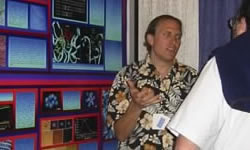|

|
California
Sea Grant
turns 30
Date goes here
Story archive

|
By Christina Johnson,
California Sea Grant,
San Diego, California
USA. This
article first appeared
in Oceanography • Vol.
16 • No. 3/2003
As
an
institution
whose
success
has
been
inextricably
linked
to
the
vision
and
support
of
the
University
of
California,
California
Sea
Grant
celebrates
Scripps
Institution
of
Oceanography’s
centennial
and
also
a
milestone
of
its
own—that
of
turning
30
in
October
2003.
National
Sea
Grant,
the
command
center
of
the
nation’s
Sea
Grant
network,
came
into
existence
on
October
17,
1966,
when
President
Lyndon
B.
Johnson
signed
into
law
the
National
Sea
Grant
College
and
Program
Act.
The
act’s
goal
was
to
make
the
oceans
more
productive
in
the
service
of
people
and
the
nation.
Reduced
to
its
essentials,
Sea
Grant
was
to
figure
out
how
to
best
use
the
ocean
and
how
to
best
preserve
it—a
delicate
balancing
act
we
continue
to
struggle
with
today.
In
those early years,
Sea Grant supported
a handful of research
activities scattered
on campuses throughout
the state. With
a vision of pooling
the state’s
resources, Scripps
Director William
A. Nierenberg aptly
championed the
University of California—and
in particular Scripps—as
the place California
Sea Grant should
call home. In large
part because of
Nierenberg’s
support, the National
Oceanic and Atmospheric
Administration
(NOAA), our parent
organization, formally
designated the
University of California
an official Sea
Grant “College
Program” at
an awards ceremony
in Berkeley on
October 25, 1973.
We were the nation’s
seventh Sea Grant
College and would
soon establish
ourselves as the
largest in the
United States.
|
 |
University
of California
researchers
Pat Conrad
(left)
and Melissa
Miller
examine
a lung
scan
of a
dead
sea otter.
Their
research
has demonstrated
that
a cat
parasite,
Toxoplasma
gondii,
is infecting
the endangered
otters
with
an often-lethal
brain
disease.
(Photo:
UC Regents) |
Our out-of-the-block
success can be
partially credited
to old Scripps
heroes John Isaacs
and Fred Spiess,
who as directors
of the University
of California
Institute for
Marine Resources—a
now dissolved
but then statewide
marine science
program headquartered
at Scripps—oversaw
the Sea Grant
program. Isaacs
and Spiess, as
well as early
Sea Grant directors
George Shor,
Jeff Frautschy,
and Jim Sullivan,
put the Sea Grant
program on a
track of excellence.
At
our
helm
today
is
Russell
Moll,
an
ecologist
by
training
and
former
director
of
Michigan
Sea
Grant.
Under
his
leadership,
California
Sea
Grant
continues
the
tradition
of
being
the
largest
of
the
now
30
Sea
Grant
programs
in
coastal
and
Great
Lakes
states.
In
the
2003
fiscal
year,
California
Sea
Grant
channeled
approximately
$6.6
million
in
federal
and
state
funds
into
coastal
marine
research,
public
outreach,
and
education
projects
in
California.
These
funds
supported
about
40
research
and
outreach
projects
at
19
academic
institutions
and
marine
laboratories
in
the
state,
as
well
as
39
scholarships,
fellowships,
and
graduate
stipends.
The research projects
we fund are competitively
peer reviewed, but
unlike a purely basic
science funding agency,
our organization looks
for opportunities to
support research with
direct and tangible
applications to real-world
problems. We want to
solve problems for
society, or to provide
science that allows
others to do so. Here
are recent examples
of marine issues in
California and our
efforts to address
them:
When bacterial pollution
closed beaches in Orange
County, Sea Grant looked
to develop tools for
improved monitoring
of potentially dangerous
human pathogens in
coastal waters.
When a fish virus discovered
in Pacific sardines
threatened to shut
down a $12-million-a-year
export industry, we
supported research
to examine whether
commercial freezing
of sardines could eliminate
viral contamination.
Because of over harvesting,
sturgeon in the Caspian
Sea region are on the
verge of extinction.
We helped create the
sturgeon aquaculture
industry, which today
gives consumers an
alternative to wild-caught
caviars.
|

|
James
Weaver
(left)
won
first
place
for his
poster
at
Sea
Grant’s
Graduate
Research
Symposium
in
2002.
(Photo:California
Sea Grant).
|
The
list
continues,
but
our
emphasis
is
clear.
Sea
Grant
seeks
to
bring
science
to
the
people
who
ply
their
livelihoods
from
the
sea.
In
addition
to
supporting
marine
research,
each
Sea
Grant
college
has
an
Extension
Program
and
a Communications
Department.
In
California,
our
extension
program,
supported
jointly
by
the
University
of
California’s
Cooperative
Extension,
is
made
up
of
nine
marine
science
experts
who
provide
hands-on,
at-the-dock
assistance
to
fishermen,
fish
farmers,
boat
owners
and
government
scientists,
among
others.
Some
recent
projects
include
the
following:
- Leading
demonstrations
of
nontoxic
hull
paints
to
reduce
the
amount
of
copper
leaked
from
traditional
antifouling
hull
paints
into
bays,
- Teaching
the
shipping
industry
about
the
ecological
ramifications
of
aquatic
species
invasions
and
their
spread
through
discharging
ballast
water,
and
- Helping
oyster
farmers
test
new
growing
techniques
for
reducing
losses
from
disease.
Underlying
Sea Grant’s
mission
is the
strongly
held
belief
that
science
must
be shared
with
others
if it
is to
have
an impact.
This
is the
main
charge
of our
award-winning
Communications
Department.
In communications,
we translate,
distill,
and publish
our research
findings.
You may
find
our work
in a
newspaper,
magazine,
book,
poster,
or on
the Internet.
California
Sea Grant
will
soon
turn
30. That
is a
milestone,
one that
has been
made
possible
by NOAA,
National
Sea Grant,
the University
of California,
and many
folks
at Scripps.
Happy Centennial!
Top l Story archive |
|
|
|
|
|





